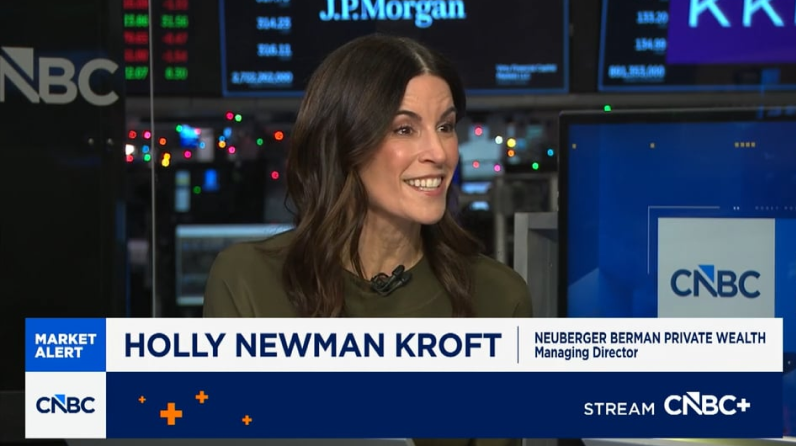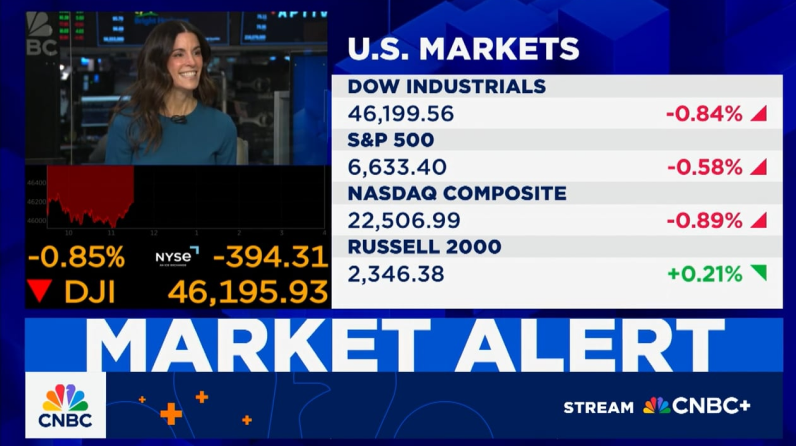

The rapid collapse of Silicon Valley Bank and Signature Bank sent shockwaves through the financial markets on Monday, March 13th with global banking stocks leading the selloff.
The following views are those of NB Private Wealth’s Private Wealth Investment Group. Private Wealth Investment Group leverages the broad expertise of Neuberger Berman to help develop investment solutions for U.S.-based private clients and works closely with wealth advisors, portfolio managers and clients with the goal of designing and implementing customized and diversified investment plans.
Silicon Valley Bank Financial Group (SVB), a regional bank with primarily tech and venture capital clients, was shut down on Friday by California regulators, making it the largest bank failure since 2008. The regulators put SVB into receivership and appointed the Federal Deposit Insurance Corporation (FDIC) as receiver, which will dispose of SVB's assets. On Sunday, regulators also moved to swiftly close New York’s Signature Bank, another stressed regional lender with large exposures to cryptocurrency-related deposits and commercial real estate. The rapid collapse of these banks sent shockwaves through the financial markets, with global banking stocks leading the selloff and the S&P 500 Index briefly dropping below 3,810 during Monday’s session, temporarily wiping out the year’s gains. U.S. banks shed over $240 billion in market value and European banks lost over $63 billion cumulatively from Thursday through Monday1. U.S. Treasuries, in contrast, rallied in a “flight to safety,” with the yield on the 10-year U.S. Treasury falling nearly 46 basis points between Thursday and Monday, when it reached 3.53%. Not surprisingly, regional banks within the S&P 500 were significant laggards, down nearly 26% as of Monday since Thursday on fears of possible contagion.
What happened to SVB and Signature?
SVB's collapse is partly a consequence of the speed and magnitude in tightening by the Federal Reserve diffusing through the economy. In general, banks take in deposits and typically lend to creditworthy customers and/or invest the excess deposits to earn a fee (“spread”) as part of this intermediation service. SVB’s depositor base was highly concentrated in venture capital-backed startups and early-stage companies that tend to draw down that cash to meet operational needs. Given SVB’s reputation of working with start-ups, the bank saw a substantial increase in deposits during the pandemic. For example, in March 2021, SVB’s deposits grew to $124 billion compared to $62 billion a year earlier (source: Bloomberg). SVB invested excess deposits in high-quality fixed income government securities. As interest rates rose significantly last year, these securities posted losses. At the same time, growth-related headwinds to SVB’s depositor base caused deposit inflows to become outflows over the course of the last year. In essence, SVB had a mismatch between its assets and liabilities where its assets, despite being high quality, had a longer duration with embedded losses while its liabilities (deposits) had a much shorter duration. Depositor outflows from cash-starved companies required the sale of the longer-duration assets at a loss, leading to a breakdown in confidence and a classic “run on the bank.”
The collapse of SVB spooked the customers of Signature Bank—a regional bank with extensive exposure to another frothy asset class—who withdrew more than $10 billion in deposits on Friday. Regulators swiftly moved in and took over the bank on Sunday, and announced policies designed to prevent further contagion.
Limited Risk of Contagion
U.S. Treasury officials moved to shore up confidence in the banking sector by enabling the FDIC to protect all of SVB and Signature depositors. On Sunday, the Fed also announced the availability of additional funding to depository institutions to assure that banks have adequate liquidity to meet depositors’ needs. The banking industry is on a much stronger footing than before the Global Financial Crisis, with higher levels of capital and liquidity, along with increased regulatory oversight. While we believe the risk of contagion to the broader financial sector remains low since most large banks have well-diversified assets and depositor bases, tighter monetary policy will continue to filter through the broader economy and may affect corporate earnings, as we have mentioned in the past. As a result, we think that banks will be more conservative, which could lead to a loss in available credit in the economy and contribute to slower growth.
Portfolio Positioning
As highlighted in our recent market update, we were relatively cautious coming into the year and favored defensive positioning focused on overweighting cash and a preference for higher-quality, shorter-duration assets within both fixed income and equities, even as risk assets surged out the gate. The volatility in markets over the last few days only reinforces our conviction in maintaining a defensive posture. The emergency measures put into place over the weekend attempted to calm the market. However, they also stoked a flight to safety as rates across the yield curve fell dramatically on Monday, with the yield on the U.S. two-year Treasury falling nearly 61 basis points to 3.98% while the 10-year yield fell to 13 basis points to 3.57%. These trends reversed slightly on Tuesday morning after February’s inflation print, which generally was in line with consensus. It showed an acceleration in prices for core goods and services of 0.5% month-over-month relative to the expected 0.4%, sending the U.S. two-year Treasury yield to as high as 4.37%. While much uncertainty remains, the market is now expecting the Fed to limit further interest rate hikes as it balances financial stability and recession concerns alongside inflation.
Against this backdrop, we anticipate that security dispersion in both credit and equity markets will continue to increase as fundamentals and active management become key focuses for investors. The situation remains very fluid, however, and we will continue to monitor the unfolding events and adjust our positioning as needed.
Source: Bloomberg, total returns as of March 13th, 2023. S&P 500 Index is represented by S&P 500 Total Return Index. Nasdaq 100 NASDAQ-100 Total Return Index. Dow Jones is represented by Dow Jones Industrial Average TR. Large Cap is represented by Russell 1000 Total Return Index. Mid Cap is represented by Russell Midcap Index Total Return. Small Cap is represented by Russell 2000 Total Return Index. All Cap is represented by Russell 3000 Total Return Index. Large Cap Growth is represented by Russell 1000 Growth Total Return. Large Cap Value is represented by Russell 1000 Value Index Total Return. Small Cap Growth is represented by Russell 2000 Growth Total Return. Small Cap Value is represented by Russell 2000 Value Total Return. ACWI is represented by MSCI ACWI Net Total Return USD Index. ACWI ex US is represented by MSCI ACWI ex USA Net Total Return USD Index. DM Non-U.S. Equities is represented by MSCI Daily TR Gross EAFE USD. EM Equities is represented by MSCI Daily TR Gross EM USD. Cash is represented by ICE BofA US 3-Month Treasury Bill Index. U.S. Aggregate is represented by Bloomberg US Agg Total Return Value Unhedged USD. Munis is represented by Bloomberg Municipal Bond Index Total Return Index Value Unhedged USD. Munis Short Duration is represented by Bloomberg Municipal Bond: Muni Short (1-5) Total Return Unhedged USD. Munis Intermediate Duration is represented by Bloomberg Municipal Bond: Muni Intermediate (5-10) TR Unhedged USD. Investment Grade is represented by Bloomberg US Corporate Total Return Value Unhedged USD. High Yield is represented by Bloomberg US Corporate High Yield Total Return Index Value Unhedged USD. Short Duration is represented by Bloomberg US Agg 1-3 Year Total Return Value Unhedged USD. Long Duration is represented by Bloomberg US Agg 10+ Year Total Return Value Unhedged USD. Global Aggregate is represented by Bloomberg Global-Aggregate Total Return Index Value Unhedged USD. EMD Corporates is represented by J.P. Morgan Corporate EMBI Diversified Composite Index Level. EMD Sovereigns – USD is represented by J.P. Morgan EMBI Global Diversified Composite. Commodities is represented by Bloomberg Commodity Index Total Return. Commodities ex Energy is represented by Bloomberg ExEnergy Subindex Total Return. U.S. 10-Year Yield is represented by US Generic Govt 10 Yr. (1): Source: Bloomberg. Market Value for US banks is estimated using the market cap of the S&P 500 Bank Index, while the market value for European banks is estimated using the market cap of the Euro Stoxx Banks Index, both measured in USD.


VIDEO
The Kantor Group | Charles Kantor’s Year-End Reflections and Key Questions as We Head Into 2026

INSIGHTS
CIO Notebook: Dual Release of Delayed Non-Farm Payrolls Likely Supports Another Cut

INSIGHTS
Using Tax-Free Gifts for Wealth Transfer

INSIGHTS
CIO Notebook: Powell Plays the Middle as Fed Cuts Rates

MARKET COMMENTARY
Giving Thanks for Market Strength

INSIGHTS
CIO Notebook: September U.S. Non-Farm Payrolls Further Complicate the Narrative

VIDEO
Holly Newman Kroft Featured on CNBC’s Money Movers November 18
VIDEO
Plan for Peace of Mind with Our Estate Planning Organizer
MARKET COMMENTARY
Some Tricks, More Treats
INSIGHTS
CIO Notebook: Markets Rattled as Fed Leans Hawkish
REPLAY
Private Wealth Investment Outlook 4Q25
INSIGHTS
CIO Notebook: September Core CPI Comes in Late but Light
INSIGHTS
Charitable Fundraising: Moving Beyond Cash
IMPORTANT INFORMATION:
This material is provided for informational purposes only and nothing herein constitutes investment, legal, accounting or tax advice, or a recommendation to buy, sell or hold a security. This material is general in nature and is not directed to any category of investors and should not be regarded as individualized, a recommendation, investment advice or a suggestion to engage in or refrain from any investment-related course of action. Any views or opinions expressed may not reflect those of the firm as a whole. Neuberger Berman products and services may not be available in all jurisdictions or to all client types. Diversification does not guarantee profit or protect against loss in declining markets. Investing entails risks, including possible loss of principal. Investments in private equity are speculative and involve a higher degree of risk than more traditional investments. Investments in private equity are intended for sophisticated investors only. Unless otherwise indicated, returns shown reflect reinvestment of dividends and distributions. Indexes are unmanaged and are not available for direct investment. Investing entails risks, including possible loss of principal. Past performance is no guarantee of future results.
The views expressed herein may include those of the Neuberger Berman Multi-Asset Class (MAC) team, Neuberger Berman’s Asset Allocation Committee and Neuberger Berman’s Private Wealth Investment Group. The Asset Allocation Committee is comprised of professionals across multiple disciplines, including equity and fixed income strategists and portfolio managers. The Asset Allocation Committee reviews and sets long-term asset allocation models, establishes preferred near-term tactical asset class allocations and, upon request, reviews asset allocations for large diversified mandates. Tactical asset allocation views are based on a hypothetical reference portfolio. The Private Wealth Investment Group analyzes market and economic indicators to develop asset allocation strategies. The Private Wealth Investment Group also consults regularly with portfolio managers and investment officers across the firm. The views of the MAC team, the Asset Allocation Committee and the Private Wealth Investment Group may not reflect the views of the firm as a whole, and Neuberger Berman advisers and portfolio managers may take contrary positions to the views of the MAC team, the Asset Allocation Committee and the Private Wealth Investment Group. The MAC team, the Asset Allocation Committee and the Private Wealth Investment Group views do not constitute a prediction or projection of future events or future market behavior. This material may include estimates, outlooks, projections and other “forward-looking statements.” Due to a variety of factors, actual events or market behavior may differ significantly from any views expressed. Nothing herein constitutes a prediction or projection of future events or future market or economic behavior. The duration and characteristics of past market/economic cycles and market behavior, including length and recovery time of past recessions and market downturns, is no indication of the duration and characteristics of any current or future market/economic cycles or behavior. Due to a variety of factors, actual events or market behavior may differ significantly from any views expressed or any historical results.
The information in this material may contain projections, market outlooks or other forward-looking statements regarding future events, including economic, asset class and market outlooks or expectations, and is only current as of the date indicated. There is no assurance that such events, outlook and expectations will be achieved, and actual results may be significantly different than that shown here. The duration and characteristics of past market/economic cycles and market behavior, including any bull/bear markets, is no indication of the duration and characteristics of any current or future be market/economic cycles or behavior. Information on historical observations about asset or sub-asset classes is not intended to represent or predict future events. Historical trends do not imply, forecast or guarantee future results. Information is based on current views and market conditions, which will fluctuate and may be superseded by subsequent market events or for other reasons.
Discussions of any specific sectors and companies are for informational purposes only. This material is not intended as a formal research report and should not be relied upon as a basis for making an investment decision. The firm, its employees and advisory accounts may hold positions of any companies discussed. Nothing herein constitutes a recommendation to buy, sell or hold a security. It should not be assumed that any investments in securities, companies, sectors or markets identified and described were or will be profitable.
The “Neuberger Berman” name and logo are registered service marks of Neuberger Berman Group LLC.
